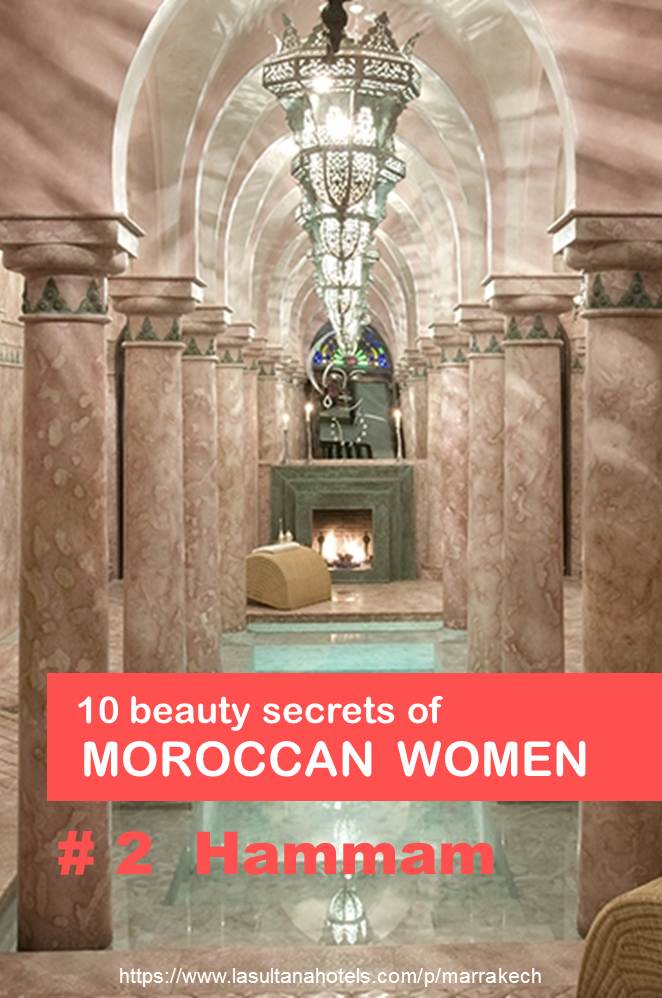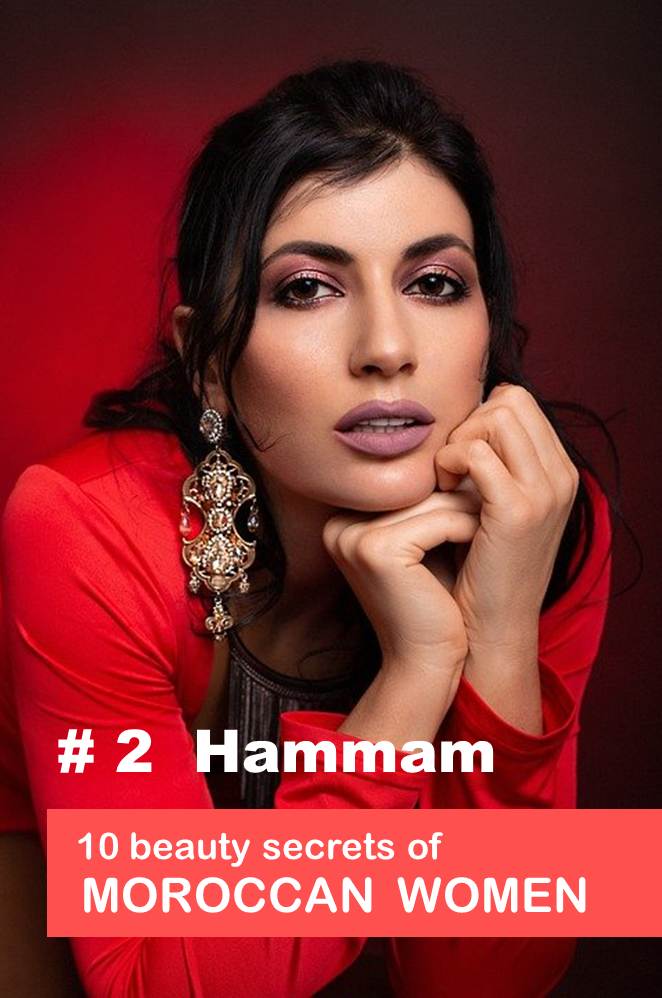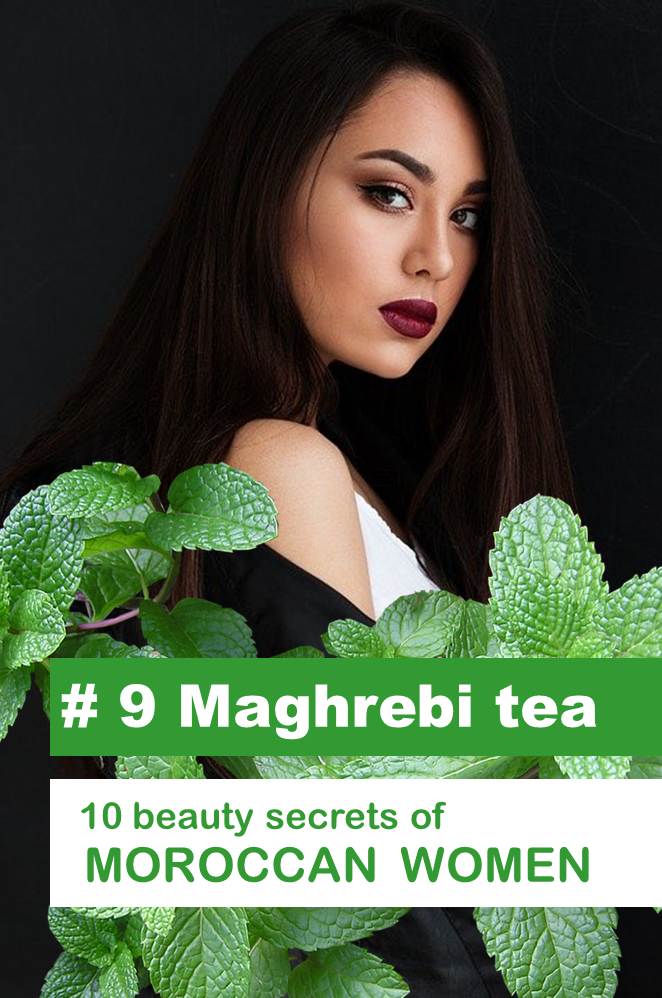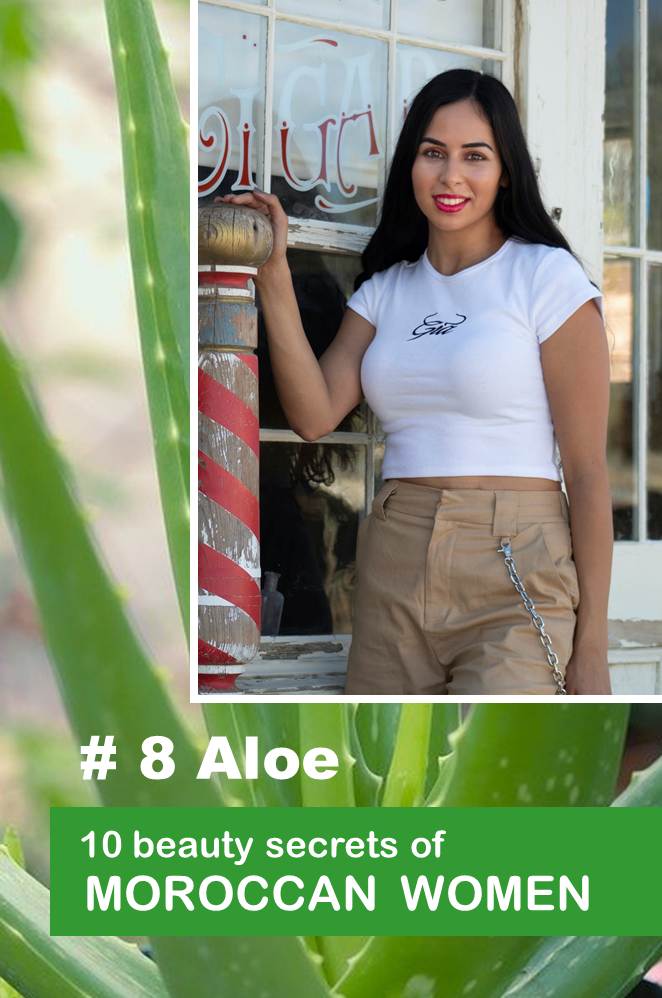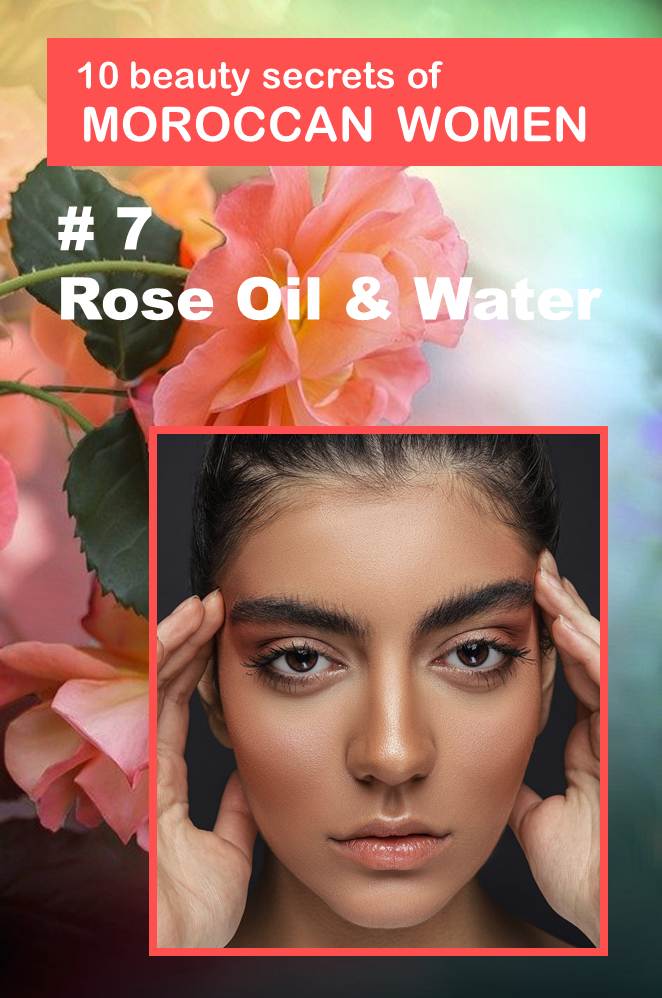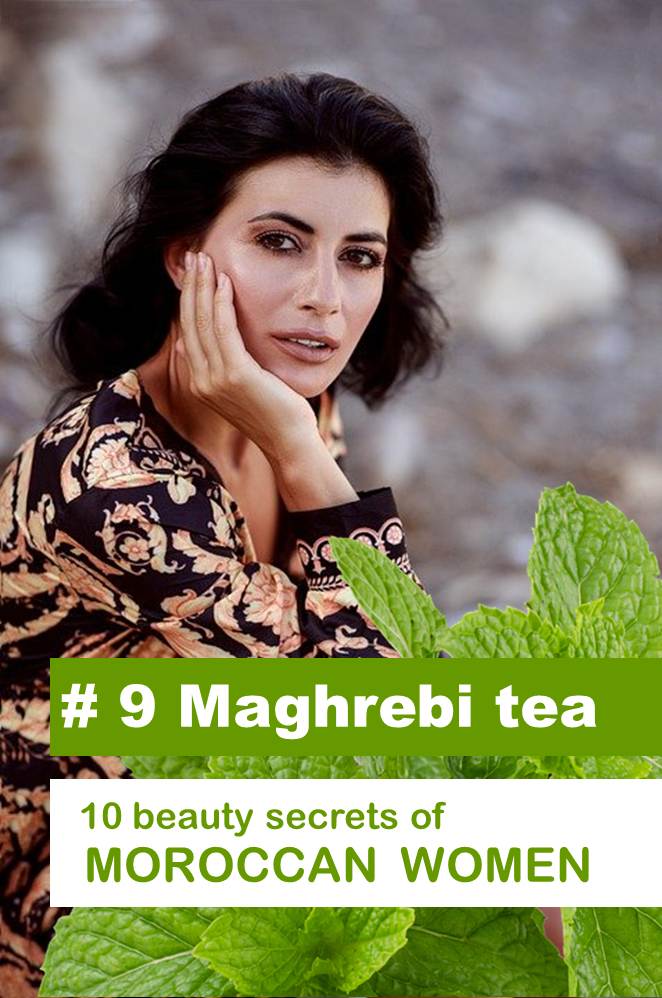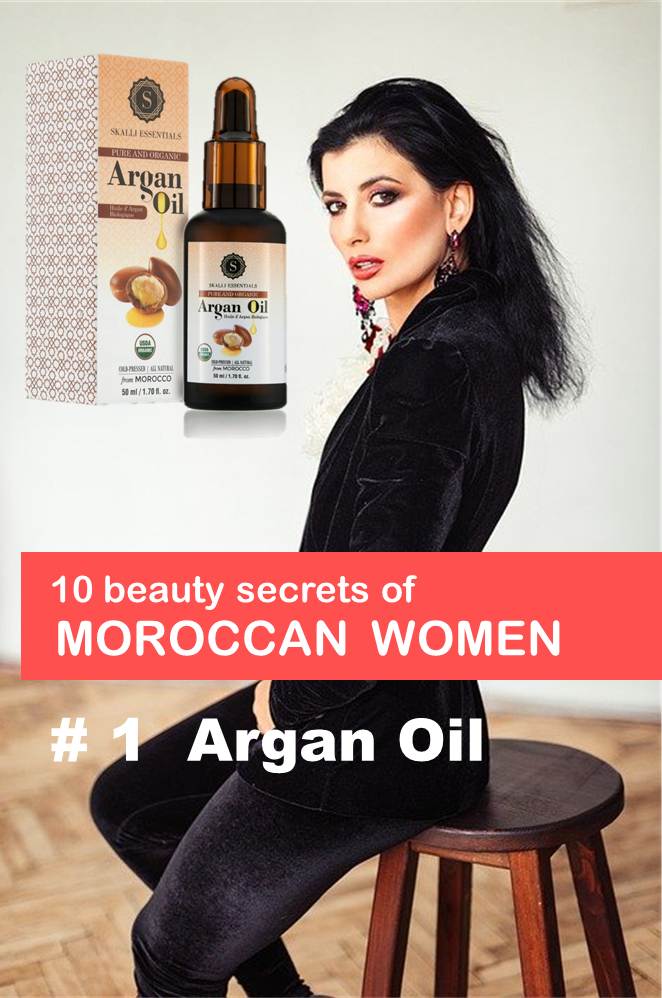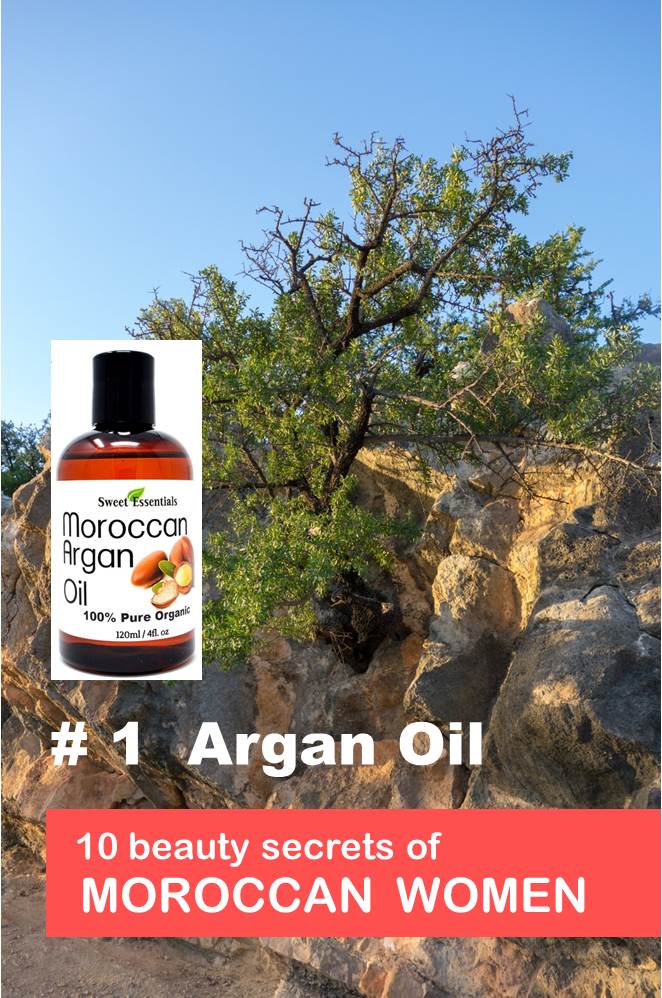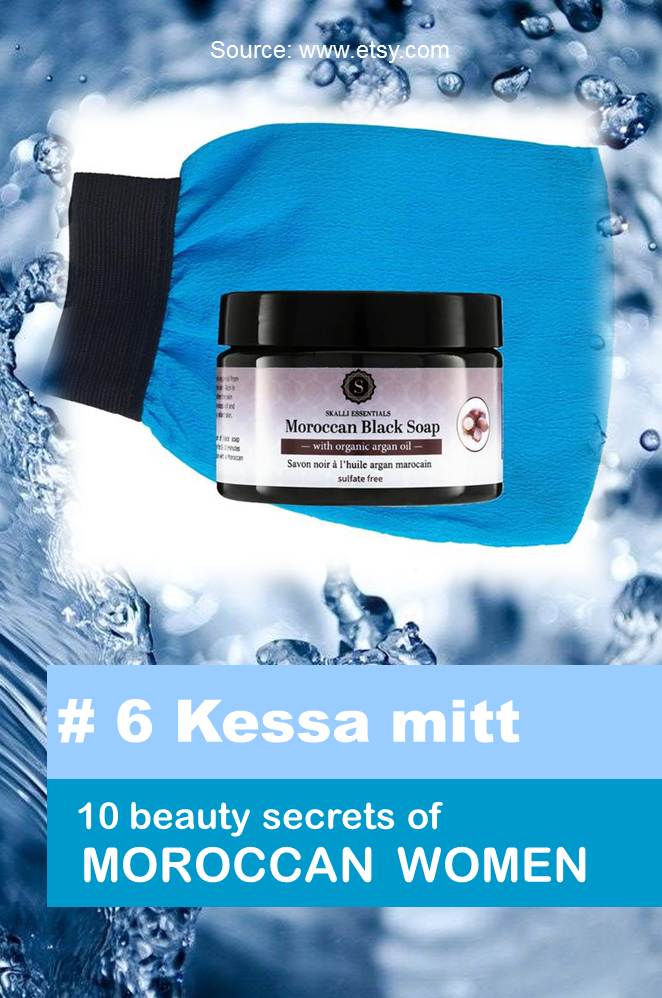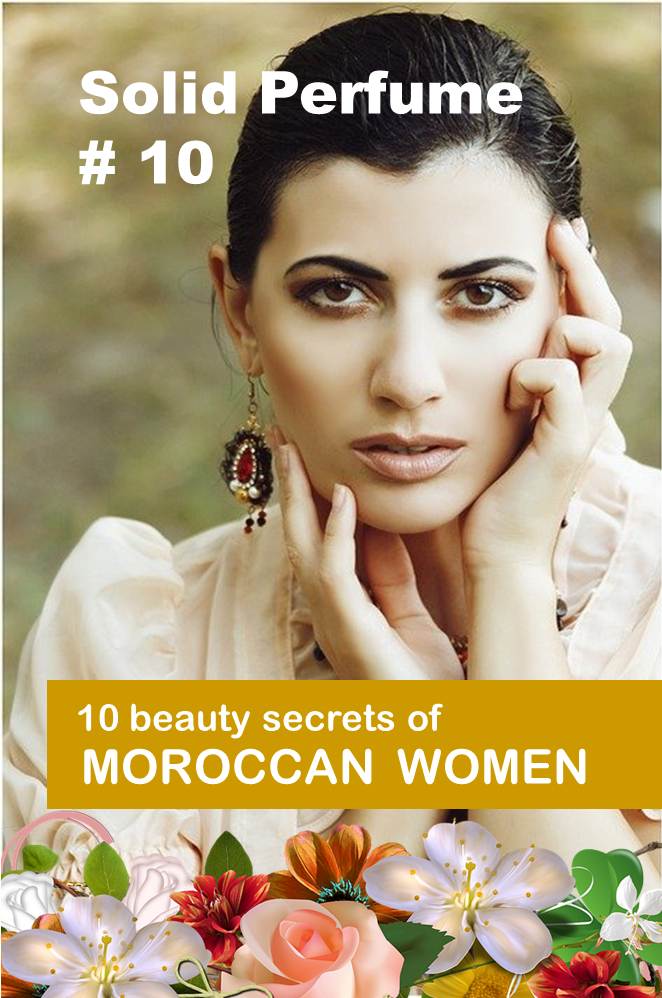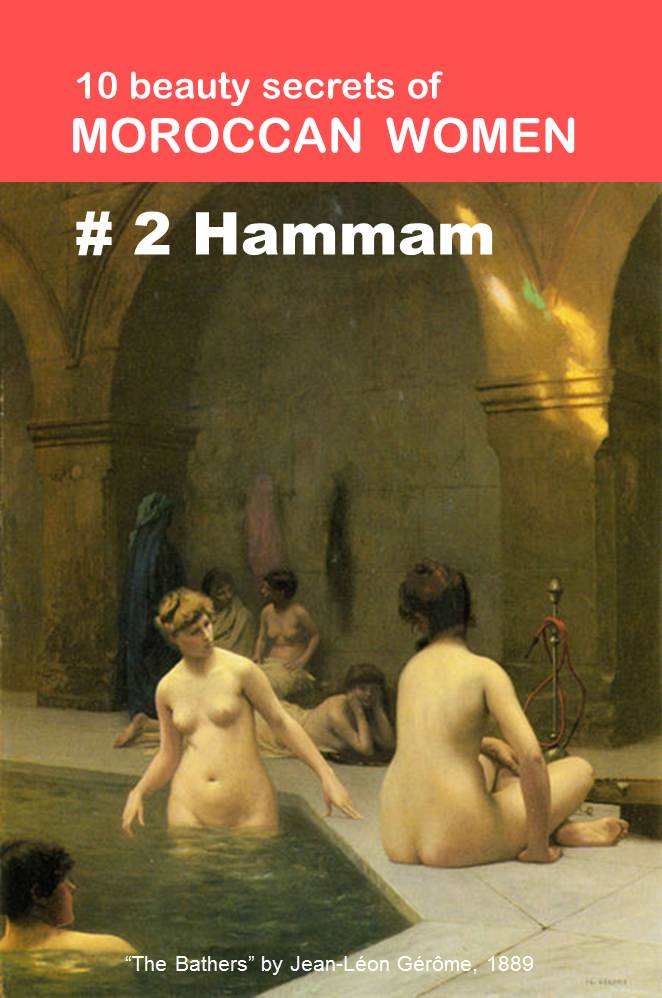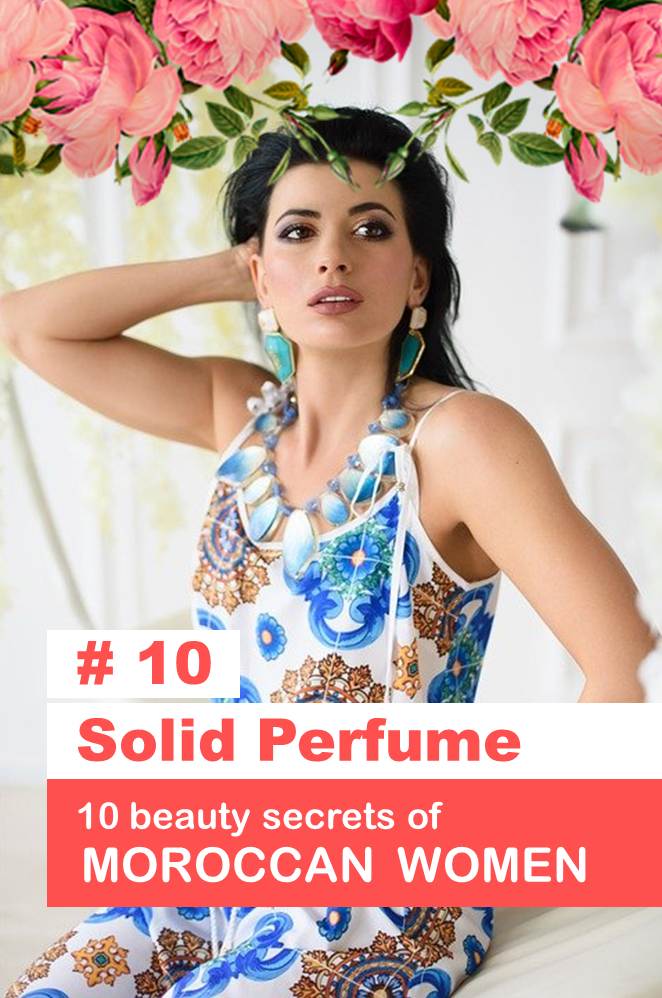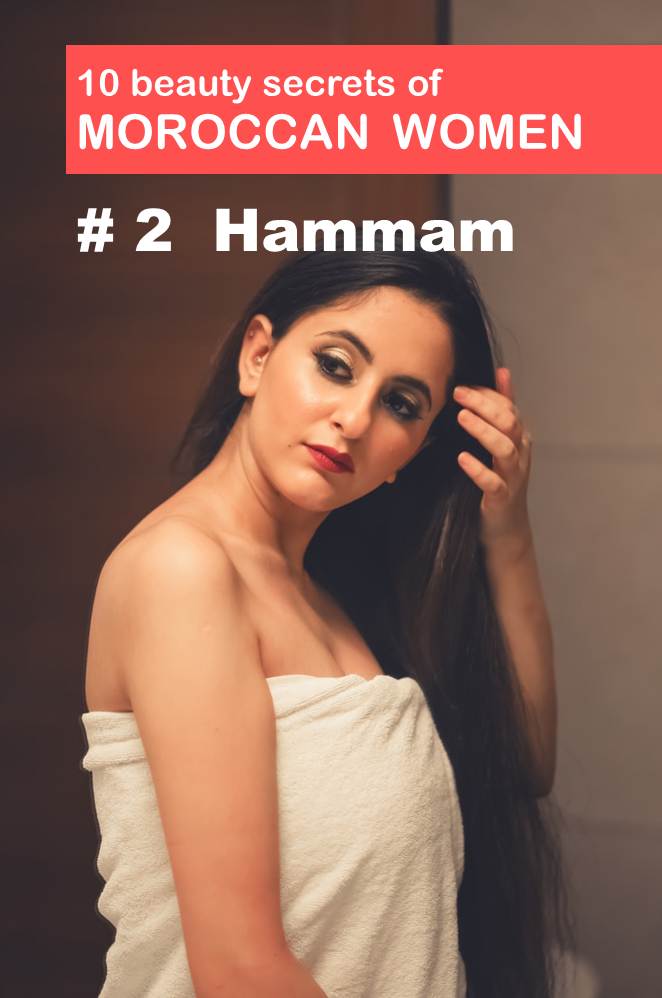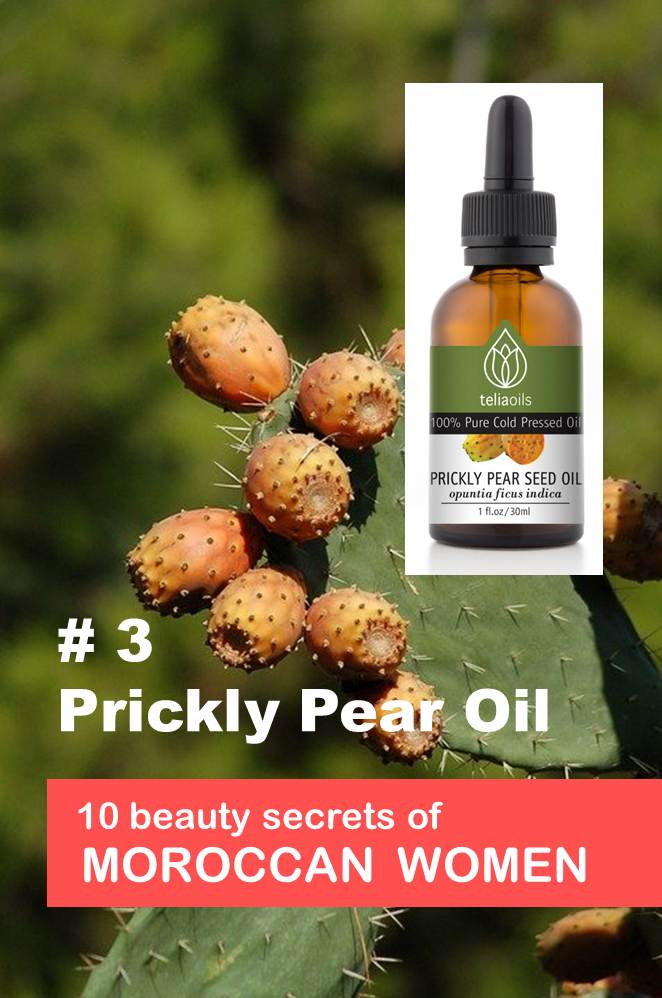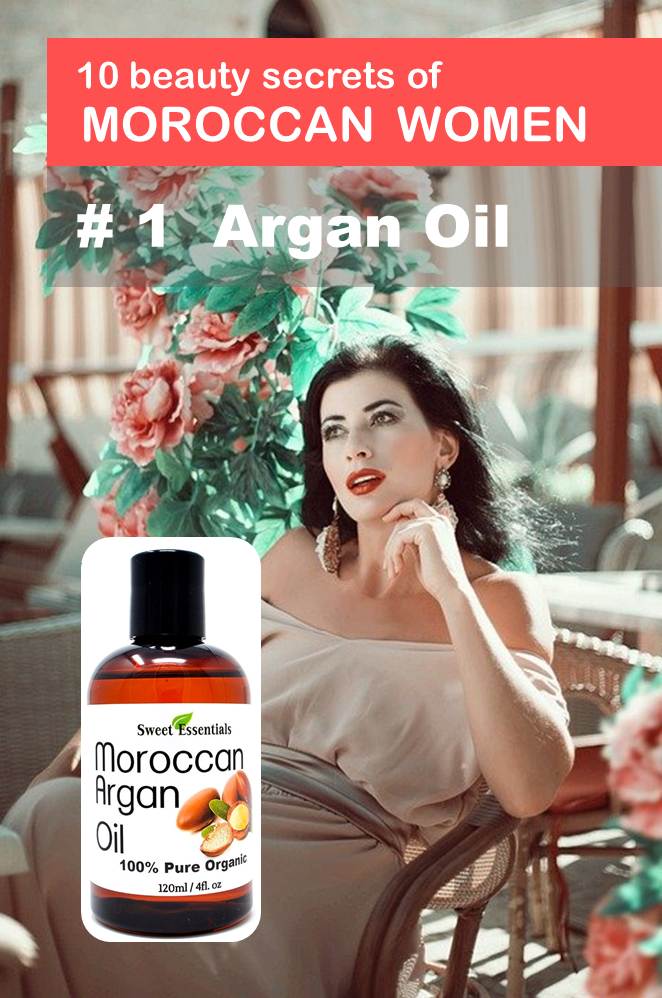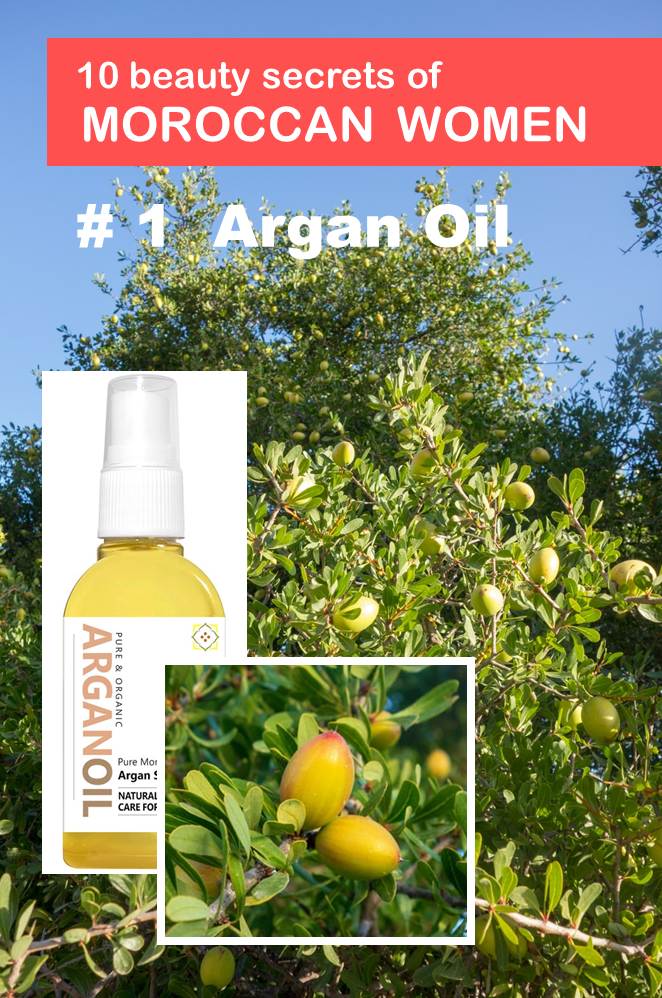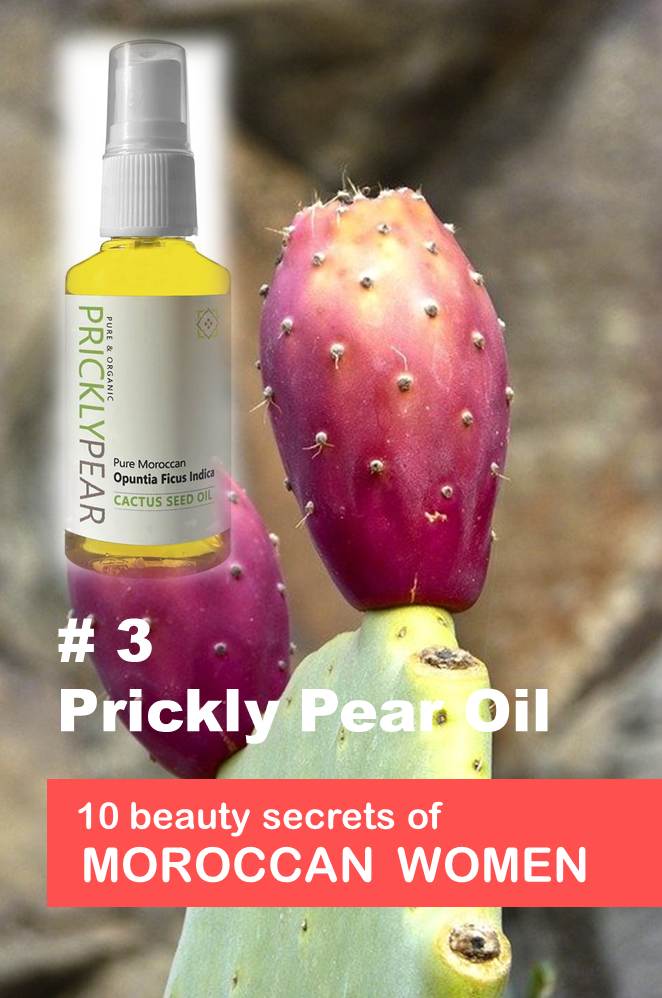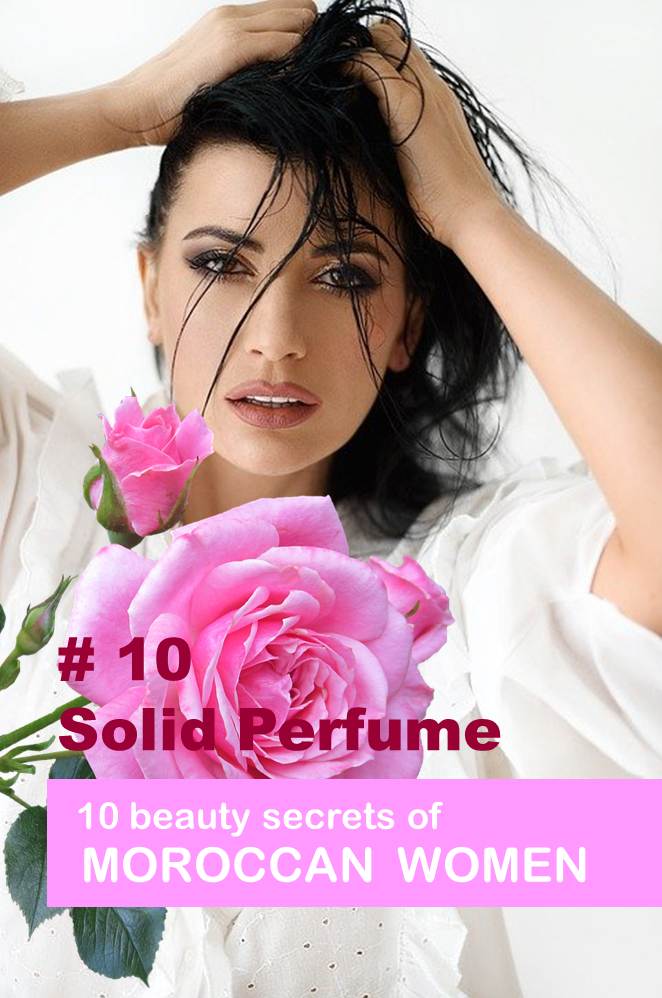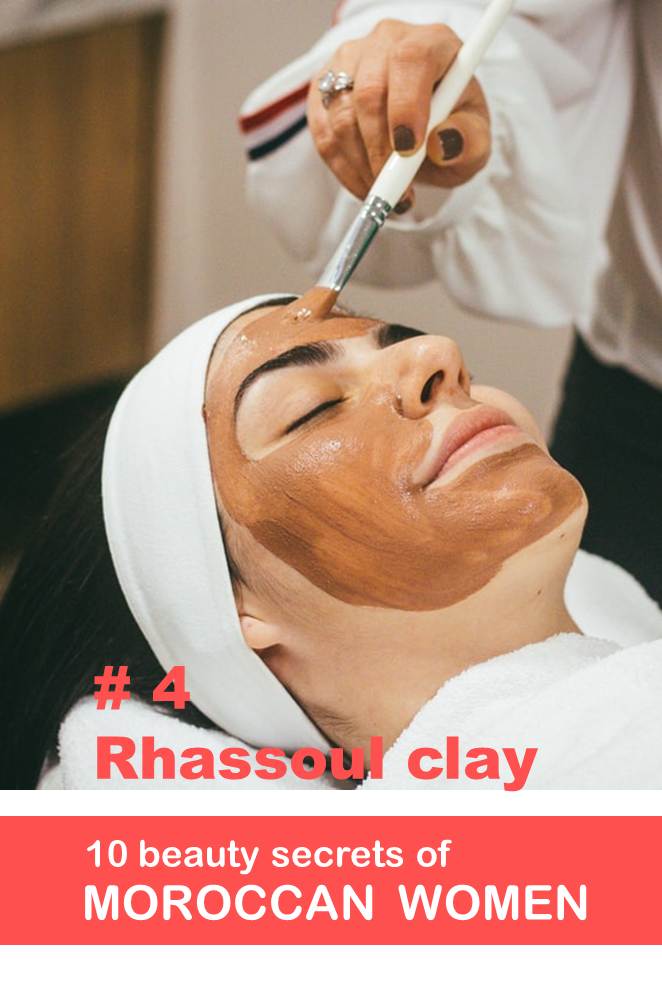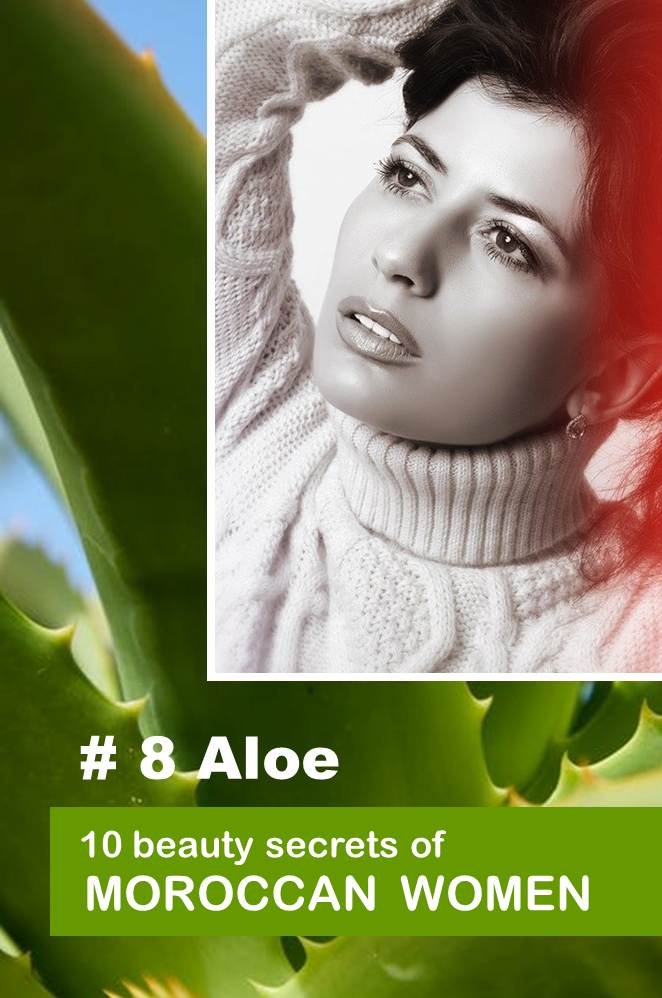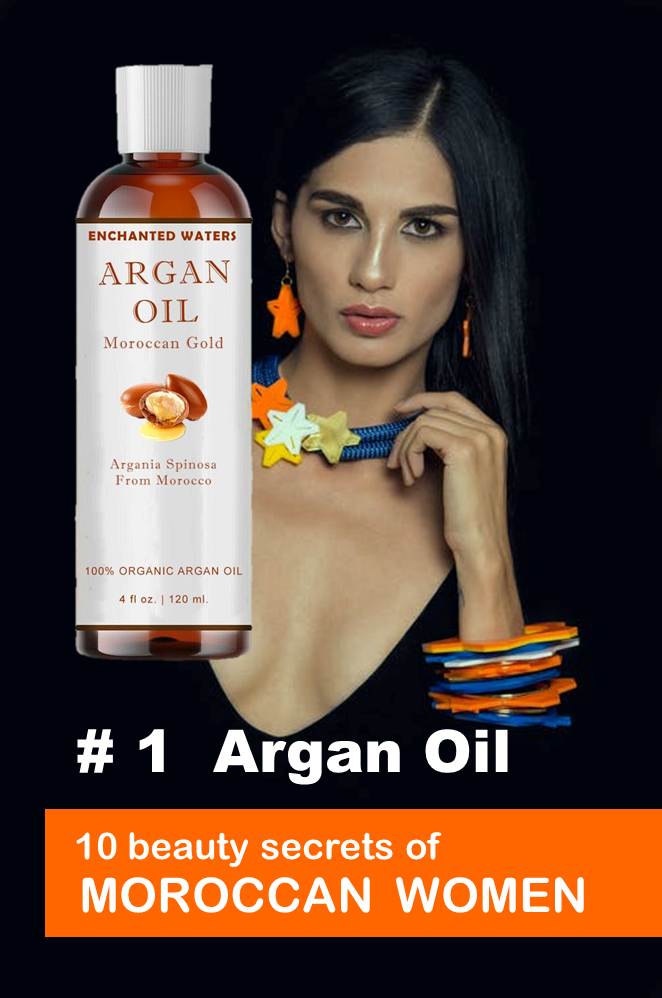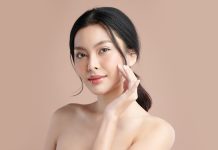By Natalia Grytsan, PhD in biology
Moroccan women have been renowned for their natural beauty for centuries. Shiny silk hair, eyes of unique beauty and delicate skin – this image of a Moroccan girl pops up in our imaginations. Even at the time of active intervention of the West in the local beauty industry, Morocco remains a country wrapped in the silk scarf of mysterious legends and the smell of a thousand spices.
Are Moroccan women as beautiful as they are said to be?
The mysterious country of Morocco has always attracted tourists. People flock to this African corner to explore the culture and traditions of the Moroccans. And even more, everyone wants to know – are Moroccan women really as beautiful as they are said to be?
World’s giants use Moroccan beauty secrets for their cosmetic hits
The specialists from many famous cosmetic companies, traveling all over the world in search of the most effective beauty recipes, have carefully studied the content of natural cosmetics used by Moroccan women. It is no secret that the world’s beauty giants borrowed many valuable and unique ingredients for their cosmetic hits “from the cosmetics bags” of Moroccan women.
For centuries, Moroccan beauty secrets pass from mother to daughter
Despite the rapid development of the beauty industry, Moroccan women still use their own personal care methods. The beauty of oriental women excites the imagination of men and attracts everyone’s attention. Moroccan women have their own beauty rituals, the effectiveness of which is superior to many salon procedures. The combination of unique ingredients and national traditions allows Moroccan women to have flawless skin, a radiant face and shiny hair.
Moroccan women know the secrets of beauty, because they pass them from mother to daughter, from generation to generation. For centuries, Moroccan women have been turning to natural, home grown ingredients in order to achieve their radiant complexions and glossy strands.
10 beauty recipes that Moroccan women know will help you always look amazing.
#10
Solid Perfume
 Like everywhere in the world, Moroccan women love perfumes, but only perfumes they use differ from the usual bottles not only in consistency, but also in concentration. Girls there prefer solid perfumes with a fairly richer smell to liquid perfumes due to the presence of a larger amount of essential oils in them. Moroccan solid perfume is like nothing you’ve seen before. They come in small, coloured blocks that give a light smell when rubbed on the skin that lasts all day.
Like everywhere in the world, Moroccan women love perfumes, but only perfumes they use differ from the usual bottles not only in consistency, but also in concentration. Girls there prefer solid perfumes with a fairly richer smell to liquid perfumes due to the presence of a larger amount of essential oils in them. Moroccan solid perfume is like nothing you’ve seen before. They come in small, coloured blocks that give a light smell when rubbed on the skin that lasts all day.
#9
Maghrebi mint tea – green Moroccan mint tea
 Maghrebi mint tea, also known as Moroccan mint tea, is a green tea prepared with spearmint leaves and sugar, traditional to the Greater Maghreb region (the northwest African countries of Morocco, Algeria, Tunisia, Libya, and Mauritania).
Maghrebi mint tea, also known as Moroccan mint tea, is a green tea prepared with spearmint leaves and sugar, traditional to the Greater Maghreb region (the northwest African countries of Morocco, Algeria, Tunisia, Libya, and Mauritania).
Mint tea is central to social life in the Maghreb. The serving can take a ceremonial form, especially when prepared for a guest. The tea is traditionally made by the head male in the family and offered to guests as a sign of hospitality. Typically, at least three glasses of tea are served. The tea is consumed throughout the day as a social activity. The native spearmint Nana possesses a clear, pungent, mild aroma, and is the mint that is traditionally used in Maghrebi mint tea. Occasionally, other hybrids and cultivars of spearmint are used as substitutes for Nana mint. In Morocco, mint tea is sometimes perfumed with herbs, flowers, or rose water. In the cold season, they add many warming herbs like pennyroyal mint and wormwood.
How to make green Moroccan mint tea
The basic ingredients of the tea are green tea, fresh mint leaves, sugar, and boiling water. A simple and practical method of green Moroccan mint tea runs as follows:
- In a teapot, combine two teaspoons of tea-leaf with a half liter of boiling water. Allow it to steep for at least 15 minutes.
- Without stirring, filter the mixture into a stainless steel pot, so that the tea leaves and coarse powder are removed.
- Add sugar (about one teaspoon per 100 ml).
- Bring to boil over a medium heat (this helps the sugar dissolve).
- Fresh mint leaves can be added to the teapot, or directly to the cup.
Traditionally, the tea is served three times. The amount of time it has been steeping gives each of the glasses of tea a unique flavor, described in this famous Maghrebi proverb:
The first glass is as gentle as life,
the second is as strong as love,
the third is as bitter as death
#8
Aloe
 Moroccan women strongly believe in the rejuvenating and healing power of aloe. In Morocco, aloe juice and facial masks based on it are considered one of the best skin care treatments. Moroccan girls apply aloe juice or aloe gruel on their faces in the morning and in the evening, and also make homemade herbal tonics from aloe. The healing power of this plant really exceeds all expectations, because the polysaccharides contained in the leaves relieve irritation, remove redness and nourish the skin.
Moroccan women strongly believe in the rejuvenating and healing power of aloe. In Morocco, aloe juice and facial masks based on it are considered one of the best skin care treatments. Moroccan girls apply aloe juice or aloe gruel on their faces in the morning and in the evening, and also make homemade herbal tonics from aloe. The healing power of this plant really exceeds all expectations, because the polysaccharides contained in the leaves relieve irritation, remove redness and nourish the skin.
You have to keep in mind that using aloe is a little bit tricky. Bio-stimulates begin to be produced about a week after the leaves are torn off. And only if at this time the leaves were kept in the cold. Otherwise, the effect of the procedure will be weak. The traditional mask prepared by the beauties of Morocco is a mixture of aloe gruel with natural honey. It is applied not only to the face, but also to the body; the mix reduces fine wrinkles and fights dryness and flaking.
#7
Rose Water and Rose Oil
 The whole air of Morocco is saturated with the mysterious and delicate scent of rose.
The whole air of Morocco is saturated with the mysterious and delicate scent of rose.
Moroccan women are far from the only ones who love rose petals, but they have made this natural product multi-functional, using it as a base for various cosmetics. For example, they make rose water from fresh petals or dried rosebuds, which they use as a tonic and completely replace water with it. The second most popular rose product is rose oil, ideal for treating dry and irritated skin. And Moroccan rose essential oil is appreciated for its healing properties: it perfectly helps to cope with stress, relaxing and relieving nervous tension.
Rose Oil
Rose oil is the essential oil extracted from the petals of various types of rose. Due to the labour-intensive production process and the low content of oil in the rose blooms, rose oil commands a very high price. Harvesting of flowers is done by hand in the morning before sunrise and material is distilled the same day.
It takes a large amount of rose petals to distil a small amount of essential oil. Depending on extraction method and plant species, the typical yield can be approximately 1:3,000.
Even with their high price and the advent of organic synthesis, rose oil is still perhaps the most widely used essential oil in perfumery, cosmetic and skin care product.
Moroccan Rose oil is considered one of the strongest essential oils for soothing and relieving ailments. When applied to the skin, it leaves it soft and glow.
Rosewater
The value of rose water goes beyond its beautiful scent. Moroccans use rosewater for cleansing and hydrating purposes, to soothe and tone the skin. It can serve as a makeup remover as well as an anti-aging serum.
Rosewater can also help treat acne and balance the skin’s pH, just by spraying it on a cotton pad and gently dabbing it on the affected area or spraying it directly onto the skin. The water can also soothe the eyes and calm inflammation.
To make rose water, Moroccan women use dried rosebuds which are available everywhere.
Rose has the ability to tone, repair and soothe irritated skin. Moreover, it is an excellent antiseptic. That is why Moroccan women use rose water both during the shower and add it to various cosmetics. Powders and dry masks are diluted with rose water; it is added to the composition for wraps. Soothing compresses are also made from rose water, which tend to relieve puffiness under the eyes. And baths with rose water relax and relieve fatigue, giving the skin a delicate scent.
#6
Kessa mitt
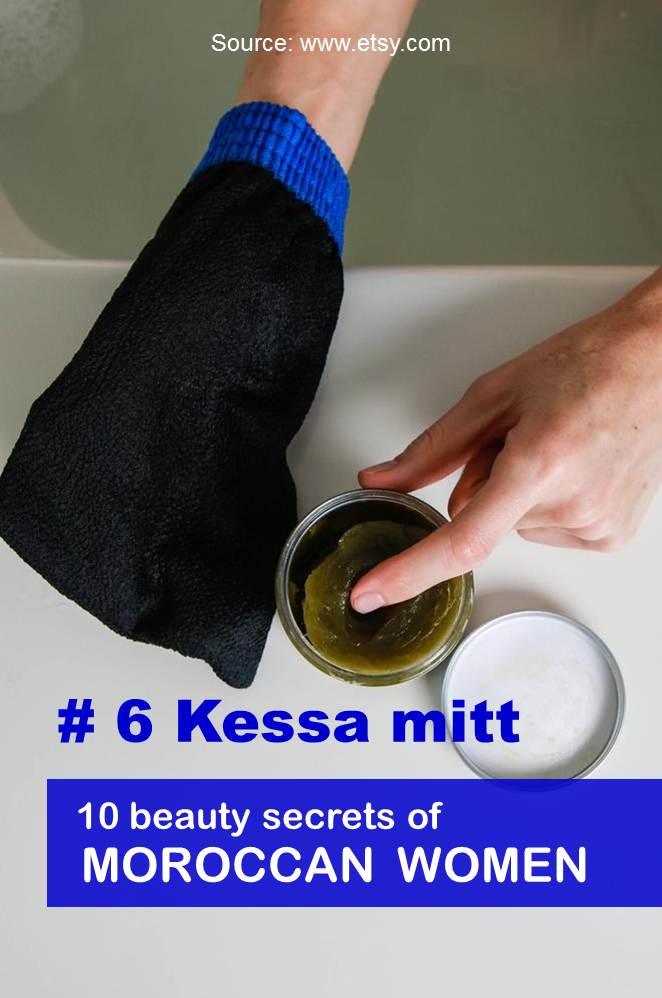 Deep exfoliation is non-negotiable
Deep exfoliation is non-negotiable
Together with beldi soap, this cleansing kessa mitt is also inseparable part of the hammam ritual. Made of twisted silk fibers (sometimes with the addition of cotton or even goat hair), it is much more effective than any sponge in removing the stratum corneum without damaging the skin. Moroccan women rub their bodies with strong energetic movements – this self-massage makes the skin unusually smooth, and in the longer term, helps to maintain youth. Important: it is better to rid the delicate areas of the body from the brisk mittens.
#5
Moroccan Beldi Soap
What is Moroccan black beldi soap?
 A “mandatory” component of beauty rituals in a traditional hammam is Moroccan black soap – beldi. This is a mint-flavoured, gel-like paste made from olive oil, macerated olives, plant extracts and glycerin. Other ingredients can enrich the Moroccan black soap, such as essential oils, eucalyptus, rosemary, or peppermint. Moroccan beldi soap is a high-alkaline Castile soap (a vegetable oil-based hard soap made in a style similar to that originating in the Castile region of Spain).
A “mandatory” component of beauty rituals in a traditional hammam is Moroccan black soap – beldi. This is a mint-flavoured, gel-like paste made from olive oil, macerated olives, plant extracts and glycerin. Other ingredients can enrich the Moroccan black soap, such as essential oils, eucalyptus, rosemary, or peppermint. Moroccan beldi soap is a high-alkaline Castile soap (a vegetable oil-based hard soap made in a style similar to that originating in the Castile region of Spain).
Moroccan black soap, beldi, should not be confused with African black soap, as the ingredients and place of manufacture are quite different.
There is no standard recipe for beldi soap
This ancient beauty secret is so widespread in the African continent that it is known to almost every woman there. However, every African country, every region in Morocco and even every family has its own exclusive recipe with its own unique ingredients of plants and oils.
Often, Moroccans buy beldi soap from Moroccan spice and herb market vendors. It’s sold by the dirham or weight, scooped from a tub into a clear plastic bag, and then transferred to a jar or plastic container at home. Some versions contain lavender oil, others rose oil; in fact, you can find black soaps containing many different extracts.
More expensive commercial varieties of Moroccan black soap, professionally packaged in jars, can be found in supermarkets and boutiques. The packaged soaps list all the ingredients, whereas the unlabeled bulk soap doesn’t.
Black Moroccan soap is not black
The most interesting thing is that the real black Moroccan soap called Savon noir has all sorts of shades of brown, but not black. If the soap is black it means that it’s made not from 100% natural ingredients and it is avoided.
Purifying properties of Moroccan beldi soap
Beldi soap is a quintessential part of the Moroccan beauty regime and the ideal place to use it is a hammam.
In the hammams of Morocco, black soap is used to cleanse, moisturize, and exfoliate the skin with the help of a coarse fabric washcloth, or “kessa” mitten, which is used to remove dead skin cells.
The all-natural beldi soap is packed with vitamin E, which helps in purifying and moisturizing the skin, as well as fighting against dullness, aging, and dehydration. In addition to making the skin smooth and silky, beldi soap has antibacterial properties that help fight skin discoloration, acne and skin irritation. It is suitable for all skin types, especially dry and mature skin.
How to use black soap to exfoliate
Black soap is scooped onto the hand and rubbed onto wet skin. It’s left on for at least a few minutes for maximum benefits. After 5-10 minutes, a coarse fabric mitten called kessa is used to remove dead skin. This leaves the skin glowing, clean and extra smooth and soft.
#4
Moroccan cosmetic clay Rhassoul (or Ghassoul)
 Rhassoul clay is another beauty endemic from the Moroccan Atlas Mountains. In its absorbent properties, this clay is four times stronger than coal and due to this fact it has become a welcome guest in the most expensive spas in the world. It not only draws out deep impurities and frees from “blackheads”, but also promotes weight loss, conceals cellulite and improves hair structure. Today, this volcanic clay is used in the most fashionable resorts and in elite beauty salons for a variety of beauty treatments.
Rhassoul clay is another beauty endemic from the Moroccan Atlas Mountains. In its absorbent properties, this clay is four times stronger than coal and due to this fact it has become a welcome guest in the most expensive spas in the world. It not only draws out deep impurities and frees from “blackheads”, but also promotes weight loss, conceals cellulite and improves hair structure. Today, this volcanic clay is used in the most fashionable resorts and in elite beauty salons for a variety of beauty treatments.
Rhassoul – another Moroccan beauty endemic
The Rhassoul or Ghassoul cosmetic clay comes from the only known deposits in the world – the Atlas Mountains of Morocco, in the Moulouya’s valley, 200 km from the Moroccan city of Fes. It is combined with water to clean the body and has been used by North African women for centuries to care for their skin and hair. Rhassoul contains silica, iron, magnesium, potassium, sodium, lithium and trace elements.
The use of rhassoul dates back to the 8th century. Moroccan women use ghassoul as part of their hammam ritual, applying the substance to their skin and hair, leaving it for approximately 15 minutes, and then rinsing it off with warm water.
In Morocco, ghassoul clay is accessible and affordable for everyone. Red clay is very popular with Moroccan women. It is found in many masks, lotions, soaps, and other skin care products. This ancient remedy was an indispensable natural product for body, face and hair care. Moroccans women use white and red clay, but green clay is considered the most healing (which is also mined only in Morocco).
Healing properties of ghassoul clay
Ghassoul has cleansing, soothing, absorbing, and regenerative properties. Along with a glove, or “kessa”, rhassoul is used as a facial mask and poultice to the body. It is intended to soften the skin, reduce sebum secretion, regenerate the skin by removing dead cells and rebalance the skin by tightening the pores. It has a unique ability that enables it to draw impurities from the skin as well as the hair. It also has detoxifying properties while cleansing and reducing dryness.
On the skin, ghassoul can help to reduce the appearance of wrinkles. Easily absorbed by the skin, it is packed with nutrients that can improve the production of collagen. The particles within the clay have a negative charge and this allows the positive impurities to get pulled from within the skin. Also, these tiny particles act as an exfoliator, removing dead skin and rejuvenating the appearance of skin.
How to use rhassoul clay
In Moroccan markets, rhassoul clay is usually sold in chunks or as a coarse powder. Commercially packaged red clay you can buy online on Etsy or another appropriate e-commerce website.
Cleansing ghassoul face mask recipe
For a glow and healthy skin, mix rhassoul clay with rosewater or regular water to make a paste. Add a couple of drops of argan or olive oil (it will make your skin not too dry). Apply the mixture to your face and neck (avoiding the eyes) and allow it partially dry for about five minutes. When the edges of the mask begin to dry, rinse it off with lukewarm water. Make sure that you don’t leave the clay mask on your face so long that it fully dries.
Use it not more than once a week. Keep in mind that if your skin is too sensitive or dry, a ghassoul clay mask may not be suitable.
Hair and scalp rhassoul treatment
Although rhassoul does not replace shampoo, it can be used on hair. Reddish-brown in colour, it can help to eliminate dandruff while also nourishing the scalp and easing eczema and psoriasis symptoms. It can bring hair back to life by reducing dryness and removing any toxins as well as product that may have built up in the hair. It also can help to improve the hair elasticity. Sometimes, in Morocco, rhassoul clay is added to shampoos.
To use rhassoul clay to treat your hair, make a paste as described above, rub it into your scalp evenly, leave for five minutes, and then rinse well.
Note that because rhassoul is alkaline, your hair might lose some luster after use. That’s why following up with an apple cider rinse is a good idea.
#3
Prickly Pear Oil
 Opuntia, commonly called prickly pear, is a large, trunk-forming, segmented cactus that may grow to 5–7 m with a crown of over 3 m in diameter and a trunk diameter of 1m.
Opuntia, commonly called prickly pear, is a large, trunk-forming, segmented cactus that may grow to 5–7 m with a crown of over 3 m in diameter and a trunk diameter of 1m.
Although prickly pear has been a staple in the Mexican and Central American diet for thousands of years, prickly pear oil is a newcomer on the beauty scene. While prickly pear oil has only recently come to the world’s attention due to its incredible anti-aging properties, Moroccan women have been extracting and using prickly pear oil for centuries.
Prickly pear seed oil is extracted from the seeds found in the fruit of the cactus – brightly-coloured, flowering bulbs that emerge from the pads during summer and fall. The fruits are hand-gathered in a laborious (and pokey) process. The seeds are extracted, dried, and pressed to obtain the light-coloured oil.
Prickly pear seed oil is one of the most expensive beauty oils in the world due to its method of extraction and the massive number of seeds it takes to make even one ounce of the oil.
Prickly pear for skin and hair
In beauty care, prickly pear oil do-it-all remedy. Prickly pear seed oil has the rare combination of a light texture and exceptional ability for deep penetration, leaving the skin extremely soft and velvety.
Research has demonstrated that prickly pear contains the highest amount of vitamin E compared to any other oil. It has 150% more vitamin E than argan oil. Additionally, it is rich in essential fatty acids that include omega 6 and 9, antioxidants, polyphenols, amino acids, and vitamin K.
The super antioxidant properties of prickly pear oil fight free radicals created from pollution and sun exposure and can help protect against aging and wrinkles.
This miracle oil delivers intense hydration to the skin, minimizes under eye circles, and treats hyperpigmentation. It soothes redness and inflammation of the skin, and helps treat and prevent acne and rosacea.
All these components nourish and protect the skin in the best way possible. High levels of vitamin K and zinc help heal dark spot and scars. The amino acids and antioxidants in the oil improve skin elasticity and appearance, especially for dry or mature skin types.
The secret of the shine and silkiness of the hair of Moroccan women also lies in the use of this amazing oil. Prickly pear cactus oil is very rare and very valuable oil that has a yellow-green colour and a pleasant herbaceous smell.
How to use prickly pear oil
One simple recipe is the following: mix a teaspoon of almond or olive oil with a few drops of prickly pear oil; apply the mixture as a daily skin moisturizer for the face, hands and body.
Another easy way is a revitalizing face mask: take one teaspoon of olive oil, one teaspoon of honey and a few drops of prickly pear oil. Mix together in the palm of the hand, then massage into the face. Leave for half an hour, then rinse.
#2
The Hammam
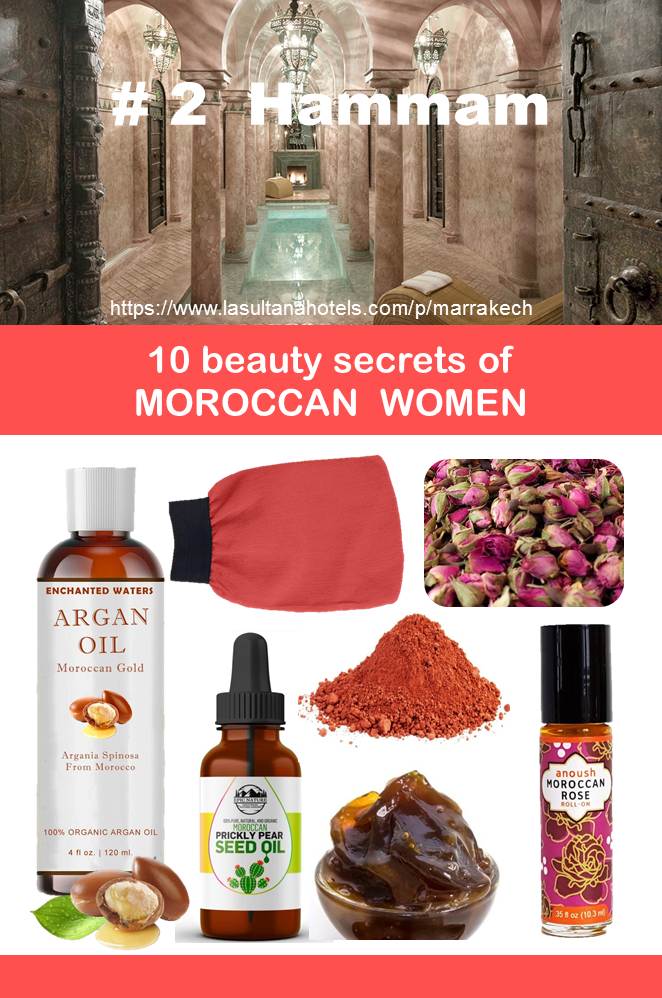 A hammam is not only a beauty ritual, but rather an important part of the Moroccan lifestyle. It’s a type of steam bath and a place of public bathing associated with the Islamic world. It is a prominent feature in the culture of the Muslim world and was inherited from the model of the Roman thermae. Muslim bathhouses or hammams are historically found across the Middle East, North Africa, Islamic Spain and Portugal, Central Asia, the Indian subcontinent, and in central and Eastern Europe under Ottoman rule.
A hammam is not only a beauty ritual, but rather an important part of the Moroccan lifestyle. It’s a type of steam bath and a place of public bathing associated with the Islamic world. It is a prominent feature in the culture of the Muslim world and was inherited from the model of the Roman thermae. Muslim bathhouses or hammams are historically found across the Middle East, North Africa, Islamic Spain and Portugal, Central Asia, the Indian subcontinent, and in central and Eastern Europe under Ottoman rule.
Since the time of the Roman Empire, the tradition of public baths has gradually disappeared throughout the Mediterranean, whereas hammams are still actively used in Morocco, Turkey and in the North of the African continent.
Moroccan hammam
The hammam is an open bathhouse that Moroccans visit at least once a week to undergo a ritual-based cleansing treatment. The treatment involves aromatherapy, detoxification, and massage using key Moroccan ingredients. Regular trips to the hammam aren’t a luxury; it’s a lifestyle and an ancient healthy tradition.
In Morocco, the hammam is a wood-fueled bathhouse that produces steaming hot water and a sauna-like atmosphere for its visitors, who come to purify their bodies and scrub off dead skin cells on a regular basis. Traditionally, Moroccan hammam is not only a bath, but also a place to gather with friends and socialize while participating in bathhouse cleansing and beauty rituals.
Special features of the Moroccan hammam
Moroccan hammam has some special features that make it standing out of any other types of bathing (including hammams in other countries). The most peculiar ones are the following four:
- Argan oil: Perhaps, the main Moroccan beauty hit is argan oil. Maybe, it is the ingredient that appears in oriental fairytales as an elixir of beauty and eternal youth?
- Ghassoul clay: Ghassoul has unique properties that help eliminate toxins. It provides excellent hydration and cleansing of the skin, thereby improving its appearance and condition.
- Black Beldi soap: It is a high-alkaline castile soap with a gel-like consistency, made from olive oil and macerated olives. This substance is also part of Moroccans’ traditional hammam skin treatment ritual.
- Kessa mitten: Moroccan women use the multipurpose soap to cleanse, moisturize, and exfoliate the skin with the help of a coarse fabric mitten, kessa, which is used to remove dead skin cells.
Moroccan hammam ritual
The Moroccan hammam belongs to steam baths. The most valuable thing in the hammam is body detoxification and deep skin cleansing. The steamed and moisturized skin ten times better absorbs all the valuable components of cosmetics. Hammam brings pleasure and bliss, an amazing sense of rebirth.
A hammam is traditionally built with three open rooms: a hot steam room for heating up the skin; a warm room for scrubbing and exfoliation; and another warm room where bathers rinse before leaving. Some modern bathhouses may have only one great big steam room. Men and women always bathe in separate areas or on separate days of the week. Some hammams offer private steaming and bathing rooms.
Bathing in Moroccan hammam
The Moroccan hammam procedure consists of the following stages:
Steaming
This stage takes place in a special steam room, which is filled with the aromas of oriental herbs and thick wet steam. The procedure continues for 20-30 minutes, which is necessary to better open the pores of the skin and prepare the body for the next stage. It’s important to keep all movements slow and smooth; too sharp moves can damage heated muscles.
Relaxing and revitalizing massage
As a rule, the massage procedure is carried out in the warmest place of the bath, on a pre-heated stone bed. During the massage, black soap and natural oils are used, which helps to remove toxins through steamed pores, as well as improve the functions of the respiratory system.
Body peeling
After massage, visitors move to another, cooler place for body exfoliation which is performed using the s Kesse gloves. Exfoliation is followed by normal bathing, shampooing, grooming and rinsing.
Cosmetic procedures
The final stage of the Moroccan hammam is cosmetic procedures, which include a body wrap using volcanic ghassoul clay. In addition to clay, the wrap contains extracts of lavender, rose, pleasant to the perception of rosemary, moss and other aromatic herbs. As a result of the above procedures, your skin becomes healthier, visibly fresher and younger, and your mood improves for a long time.
Before leaving, people relax a while with Moroccan mint tea.
#1
Argan Oil
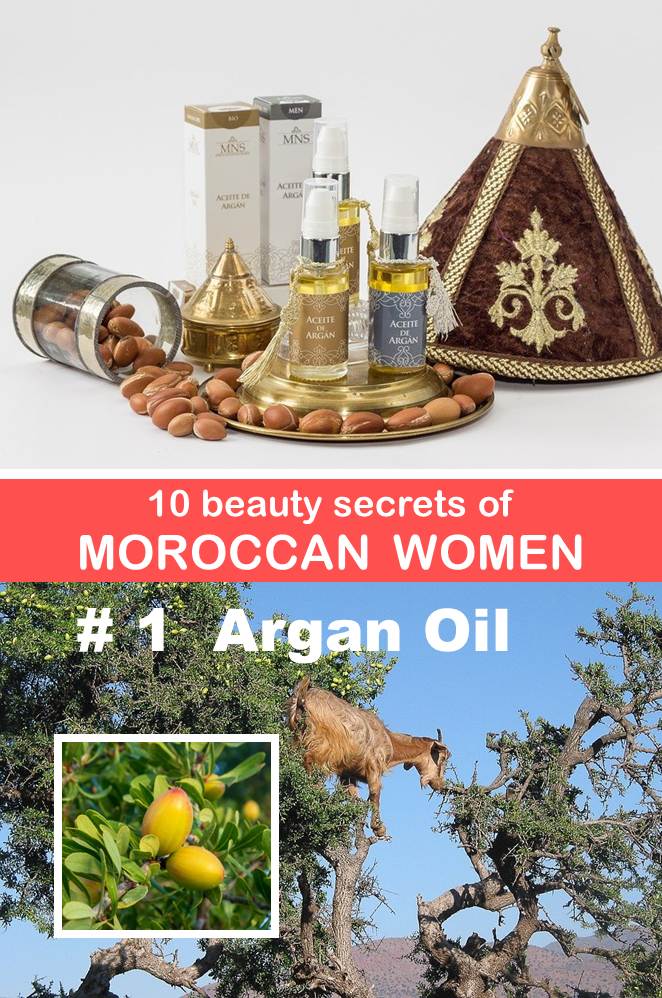 Perhaps, the main Moroccan beauty hit is argan oil. Maybe, it is the ingredient that appears in oriental fairytales as an elixir of beauty and eternal youth?
Perhaps, the main Moroccan beauty hit is argan oil. Maybe, it is the ingredient that appears in oriental fairytales as an elixir of beauty and eternal youth?
Argan oil is obtained by cold pressing from the kernels of the argan tree, which grows only in one place on the planet – on the outskirts of the Sahara, in the Southwestern Morocco. The argan tree is equipped to stand the desert areas, as it has deep roots and small leaves that allow it to resist the wind and lack of water.
Argan Oil – Morocco’s Liquid Gold
The oil has a high antioxidant and antibacterial effect, stimulates collagen production and protects against ultraviolet rays. Its unique dermatological properties make argan one of the most expensive in the world (thus, the popular name “liquid gold” has a double meaning). Traditionally in Morocco, it has been used for medicinal purposes – against eczema, psoriasis, severe acne and hair loss. In the modern beauty industry, argan oil is considered one of the most effective skin moisturizer. It also smells divinely.
Unique properties of argan oil
Moroccans call argan oil “liquid gold” not because of its price (in Morocco, it’s affordable for all) but because of its incredibly healing, anti-aging and soothing power. It’s even difficult to list all skin problems and health conditions that argan oil cannot successfully cope.
The oil contains a significant amount of vitamins and antioxidants, as well as antibacterial and anti-inflammatory properties. This is great for treating wounds, healing skin infections, countering acne, and addressing other skin conditions.
Argan oil is a great moisturizer thanks to its high level of vitamin E. Argan oil can help restore the skin’s elasticity and leave it feeling plumper and softer, making the oil a great anti-aging product.
The high content of vitamin E and antioxidants makes the skin glow: after a mask of argan oil, fine expression lines are instantly smoothed, and deep wrinkles become less noticeable. That’s why argan oil in Morocco is almost the main component in shampoos, conditioners, creams and masks.
How to use cosmetic argan oil
To use cosmetic argan oil on the skin, all you need is one to two drops as it is very potent. Simply add the drops to your palm and massage into your face in small, round circular motions. After absorption, your face will feel soft and smooth.
To use on the hair, put a few drops of cosmetic argan oil onto your fingertips, then run your fingers through your hair from the roots to the tips. This will not only help your hair grow, but also treat split ends. Massaging argan oil into the scalp can boost scalp health.
Huge demand for argan oil
Since the early 2000s argan oil has been increasingly popular in cosmetic and hair care preparations. As of 2020, the biggest growth in demand is in the cosmetics industry, where it is being used for face creams and as an ingredient in lip gloss, shampoo, moisturisers and soaps.
By 2020, argan oil production had increased exponentially, especially after studies had suggested its health benefits. Almost all of the oil is sourced in Morocco, and is forecast to reach 17,802 tons in 2022, up from 4,387 tons in 2014; in value terms, US$1.79 billion (GB£1.4 bn).
The area of producing the oil is expanding: in 2020 it had started near the city of Agadir, 175km south of the traditional argan-producing area of Essaouira, and is due to expand north.
40 kilograms of dried argan fruit only produces one litre of oil. Mechanically extracted oil production has started, with the industrial scale driving down prices, impacting the small co-operatives, where work is mostly done by Berber women in the traditional, labour-intensive way. Mechanically produced oil can cost as little as US$22 per litre, less than half the cost of oil made by the cooperatives.
Argan oil remains one of the rarest oils in the world. However, worldwide demand for argan oil is growing rapidly. The size of this market was valued at USD 22.9 million in 2019 and is expected to expand by 10.8% over the next seven years.
The beauty secrets of Moroccan women have been tested for years. Try them at home and become even more beautiful.


